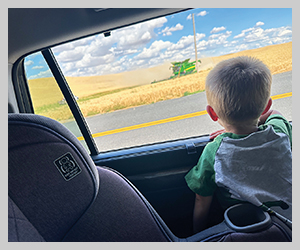Costing out carbon markets More questions than answers on nation carbon markets
2022March 2022
By Trista Crossley
Editor

At December’s 2021 Tri-State Grain Growers Convention, Shelby Swain Myers, an economist from the American Farm Bureau Federation, looked at the developing national carbon market. Her takeaway was that while there may be a financial opportunity for agriculture, there are still more questions than answers.
According to Myers, agriculture is responsible for 10 percent of overall greenhouse gas emissions. But when you take into account the forestry industry and other agricultural carbon sinks that are estimated at -12 percent, the net total for agriculture is on the minus side of the equation (-2 percent). That creates a product that other industries can use to offset their own emissions.
“They are the buyers. You all are the suppliers,” Myers said. “The problem this puts agriculture in, though, is that, yes, we are really great carbon sequesters, but our practices have environmental benefits beyond sequestering carbon. We’ve got to find ways for the incentives to not only pay for the offset carbon greenhouse gas emissions, but also pay for the additional environmental benefits these practices have in mitigating other greenhouse gas emissions. We can’t do this on our own, and we can’t do this for free.”
Carbon markets are seen as a way to incentivize conservation efforts. Currently, they are voluntary, incentive-based national markets designed to bring buyers of ecosystem asset credits together with sellers on a platform that facilitates the exchange. Payments are either based on outcomes, such as increases in soil carbon or improved water quality, or on a pay-for-practice model.
“Pay for outcome means you are going to be paid either on a dollar per credit or dollar per metric ton of whatever greenhouse gas you are sequestering,” Myers explained. “The pay for practice says they will pay you upfront to implement certain practices, say $3 per acre for strip-till, no-till, etc. That doesn’t mean they aren’t going to come out on the back end and measure what’s been sequestered. It’s just a matter of how to you want to be paid.”
In order to make the system work, those outcomes will need to be certified, quantified and verified. In other words, there will need to be a way to certify that the practice happened the way it was supposed to. The environmental benefit on that soil will have to be quantified, which will likely happen through data collection, such as soil samples. Finally, it all has to be verified by a third party.
“One of the leading issues is how to verify the outcomes consistently and economically,” Myers said. “There is so much uncertainty right now in the verification and the standards of what makes a carbon credit a carbon credit.”
An emerging issue is what to do about early adopters of conservation practices—farmers enrolled in the Conservation Stewardship Program, Conservation Reserve Program, cover crops, buffer strips, etc.—because they are already contributing to the status quo, and most buyers are looking for carbon sequestering opportunities that improve on the status quo. Myers said some programs are attempting to compensate early adopters by looking at a producer’s efforts for the past five years. The rub, however, is the producer has to provide the necessary data, including receipts. Another proposal being discussed is having the U.S. Department of Agriculture make a one-time payment to early adopters. Providing the ability to pay for multiple environmental benefits that sequester other greenhouse gases besides carbon dioxide could be another way to include early adopters.
Some of the other questions and concerns around carbon markets include:
- Rural broadband access, because all of the current programs are online.
- Data privacy issues, as companies purchasing carbon credits will be checking to make sure the practices specified by the contract are happening. That monitoring will likely include using satellite images.
- A producer’s farm management software has to be compliant with other parties’ software platforms. A producer should also be aware of how and with whom their data is being shared.
- The majority of contracts Myers has seen have been long-term contracts (more than five years). Tenants will need landlord confirmation that they will be in operating control of the land for the duration of the contract. Additionally, tenants who lease from a trust will need to have everybody in the trust sign off on the contract.
- Growers are paid on the back end of the contract the majority of the time (except for some paid for practices), so what happens if a producer doesn’t sequester carbon the way the model said they would? What about early termination?
- There are likely to be extra costs to the producer, such as soil sampling costs for verification and lawyer or accountant fees. Those need to be taken into consideration when calculating the producer’s share of the “carbon” dollar.
“Whether you agree with it or not, the opportunity is here, and it is currently voluntary,” Myers said. “This has been completely private-driven, and government is looking for ways to complement it from a public-private partnership standpoint. What this does and what this conversation starts is the ability to avoid a mandate, or in the sense of global competitors, avoid import/export taxes. There is a whole lot of money to provide incentives, and it’s important it remains voluntary.”












